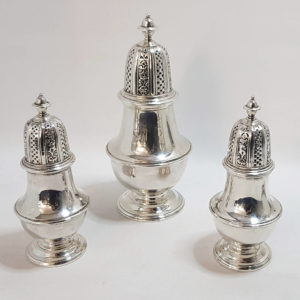Paul Crespin
Paul Crespin
Paul Crespin, a key figure in the London community of Huguenot goldsmiths, was apprenticed to Jean Pons in 1713, free by patrimony or redemption of the Company of Longe Bowe String Makers (undated). First marks (Sterling and New Standard) entered circa 1720/21. 3rd mark 1739, 4th mark (New Standard) 1740, 5th mark (two sizes) 1757.
Crespin very quickly gained a reputation as a goldsmith of the greatest ability, and attracted commissions from the sovereigns of England, Portugal, and Russia. His most important clients, such as the Prince of Wales and the dukes of Devonshire, Marlborough, and Portland, give some indication of the strength of his reputation.
Crespin’s long and illustrious career lasted from 1720 until circa 1760 working from his business address in Compton Street, London. He retired to Southampton with his wife and daughter and later died aged seventy-six.
-


1732
Paul Crespin
10103 Set of George II Antique Silver Casters
Sold
A fantastic quality set of antique sterling silver castors made by the master silversmith Paul Crespin. Classic plain style with pierced removable tops. Extremely large size, thick gauge and heavy in the hand. An unusual feature is that one small caster has been fitted with a plain inner sleeve, this is known as a “blind caster”, the earliest form of mustard pot. Height 21.5cm and 16.6cm. Weight 1056 grams, 33.9 troy ounces. London 1732 (large), 1733 (small). Maker Paul Crespin.